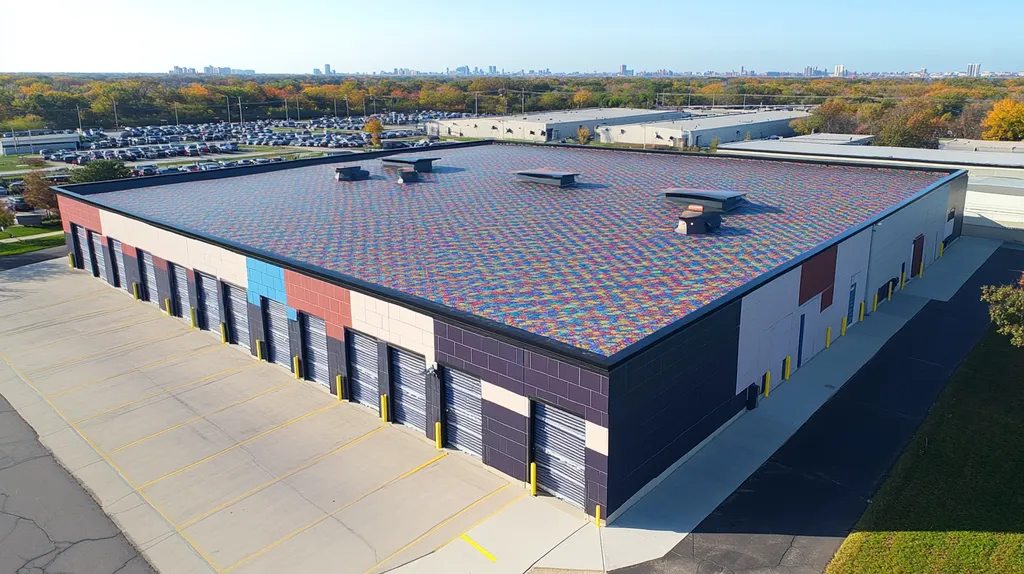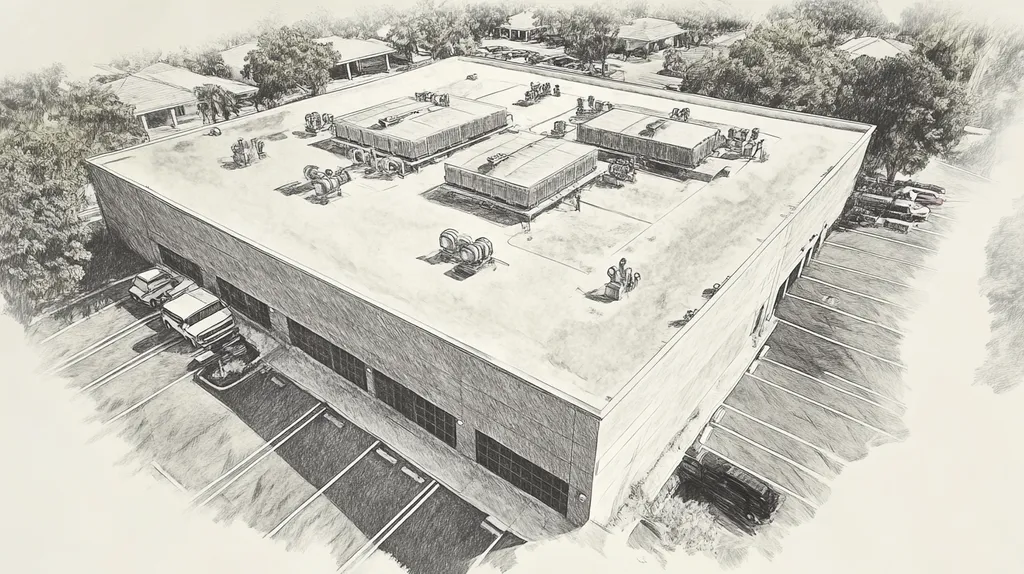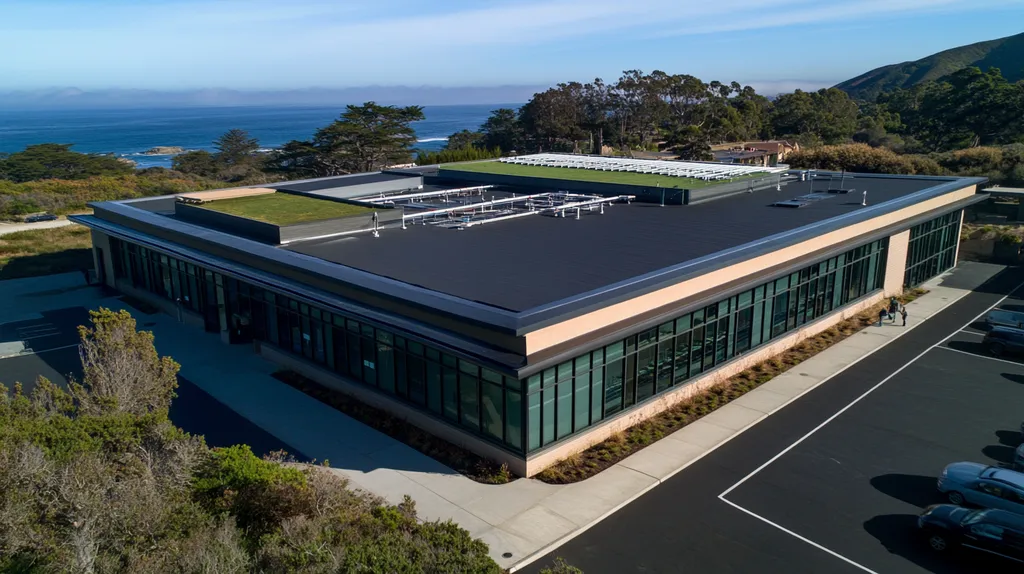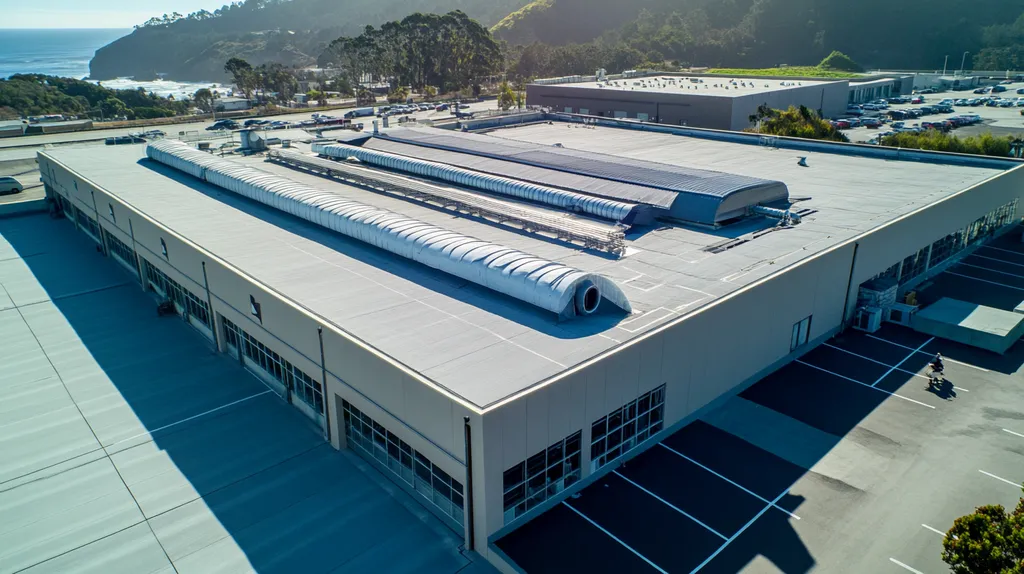Commercial roof penetrations represent critical vulnerability points, with over 70% of roof failures occurring around these areas according to the National Roofing Contractors Association. The financial impact is staggering – a single compromised penetration can lead to repairs exceeding $25,000.
Modern coating solutions offer robust protection when properly implemented. However, navigating the complexities of coating selection, application methods, and maintenance protocols requires careful consideration of multiple factors.
This comprehensive guide examines the critical performance factors, financial considerations, compliance requirements, risk management strategies, and operational procedures facility managers need to effectively protect and maintain roof penetrations.
SECTION 1: PERFORMANCE FACTORS
Facility managers must recognize the critical importance of roof penetrations. If not addressed properly, these areas can lead to expensive leaks and structural damage. Alarmingly, over 70% of roof failures result from insufficient workmanship and subpar materials, according to the National Roofing Contractors Association. A solid grasp of the performance factors associated with roofing coatings is vital for ensuring the longevity and efficiency of the roof system.
Coating Adhesion and Durability
Coating adhesion plays a pivotal role in the durability of a roofing system. Strong adhesion allows the coating to effectively bond with the substrate, preventing issues like peeling and delamination. Without it, roof penetrations can become vulnerable to water intrusion, resulting in significant damage.
Different roof materials require specific coatings for the best adhesion. For example, metal roofs often need a primer to enhance bonding. Facility managers should always refer to manufacturer guidelines to select the appropriate coating for their unique roofing materials.
Conducting regular inspections to assess adhesion can uncover potential problems early. Tackling these issues promptly helps prolong the roof’s lifespan and avoid costly repairs later on.
Key Action Items
UV Resistance and Reflectivity
Ultraviolet (UV) exposure can drastically degrade roof coatings. A coating’s UV resistance is essential for extending its lifespan and maintaining effective performance. Notably, the Cool Roof Rating Council reports that reflective coatings can reduce roof surface temperatures by as much as 30%.
High reflectivity not only boosts energy efficiency but enhances the overall performance of a building. Facility managers can reap savings on cooling costs and safeguard the roofing system from heat-related damage.
Additionally, investing in coatings with superior UV resistance guards against issues like cracking and chalking. Regular maintenance and re-coating are necessary to sustain these characteristics, emphasizing the importance of diligent planning.
Key Action Items
Flexibility and Elasticity
Roof penetrations often experience movements due to thermal expansion and external forces. The flexibility and elasticity of a coating are essential for withstanding these stresses. Agile coatings can adapt to temperature fluctuations, preventing cracks and splits.
Using flexibility-specific coatings allows them to adjust to the structural movement beneath. This is crucial in regions with pronounced temperature changes. Choosing materials with high elastic recovery can minimize future maintenance needs.
Moreover, facilities that face vibrations or mechanical stress should opt for coatings that offer enhanced elasticity. Such coatings provide much-needed protection for penetrations around pipes and HVAC systems.
Key Action Items
SECTION 2: FINANCIAL CONSIDERATIONS
Understanding the financial implications of roof penetrations and coatings is vital for facility managers. Poor management can lead to overwhelming repair costs, with some estimates suggesting that these expenses can exceed $100,000 over time. This section explores initial application costs, long-term maintenance savings, and energy efficiency benefits, providing a clear financial framework to guide decision-making.
Initial Application Costs
When evaluating commercial roof coatings, initial application costs often top the list of concerns. These costs can fluctuate based on the type of coating, roof complexity, and the extent of existing penetrations. For example, applying a basic coating to a flat roof typically costs between $1 and $3 per square foot, while more intricate systems can range from $5 to $7 per square foot.
While these upfront costs may seem intimidating, they need to be weighed against future savings. By investing in high-quality coatings, facility managers can significantly reduce the need for repairs or replacements down the road. Moreover, poorly sealed penetrations could lead to substantial water damage and structural issues, emphasizing the need for effective budgeting.
Budgeting for a roofing coating that comes with warranties lasting 10 to 20 years offers peace of mind and financial predictability. Ultimately, the decision about which roofing coating to choose should strike a balance between initial outlay and long-term value, ensuring responsible budget management.
Key Action Items
Long-Term Maintenance Savings
Implementing a commercial roof coating can unlock substantial long-term maintenance savings. Often, property owners overlook potential repair costs tied to inadequately managed roof penetrations. A well-applied coating can prolong the life of the roof, which reduces the frequency and cost of interventions.
Research shows that facilities proactively managing roof penetrations can cut maintenance expenses by more than 40%. The resilience that quality coatings provide against environmental stresses like UV rays and heavy rain contributes to this savings potential. A sturdy coating helps keep repair requirements to a minimum, which strengthens the roofing system’s overall integrity.
Furthermore, certain coatings boast reflective properties, combating degradation and translating into more savings over time. The result is a sustainable approach to maintenance that enhances the financial viability of investments related to roof penetrations.
Key Action Items
Energy Efficiency Benefits
Energy costs form a significant part of a facility’s operational budget, and reflective roof coatings can help enhance energy efficiency dramatically. By reflecting sunlight effectively, these coatings assist in maintaining cooler indoor temperatures that reduce the reliance on air conditioning.
The U.S. Department of Energy highlights that reflective coatings can lower roof surface temperatures by up to 80 degrees Fahrenheit. This reduction not only leads to a noticeable decrease in energy bills, often by 20% or more, but also extends the roofing materials’ lifespan.
Moreover, energy-efficient roofs contribute to a facility’s sustainability goals, an increasingly important factor for many stakeholders. Investing in roof coatings that offer these efficiency benefits aligns financial prudence with corporate responsibility.
Key Action Items
SECTION 3: COMPLIANCE REQUIREMENTS
Understanding compliance requirements is essential for facility managers in charge of roof penetrations and coatings. Non-compliance can lead to severe legal consequences and financial setbacks, such as fines or project delays. By grasping the complexities of compliance, managers can ensure robust roof maintenance and performance while avoiding costly pitfalls.
VOC Compliance and Regulations
Volatile Organic Compounds (VOCs) are critical considerations when selecting roof coatings. Many regions enforce strict VOC limitations to mitigate air pollution, making it imperative for facilities to use compliant roofing materials.
Take California, for example, where the South Coast Air Quality Management District imposes specific VOC thresholds for roofing products. Ignoring these regulations can incur hefty fines and necessitate the removal of non-compliant materials. Staying informed about local VOC rules is essential for avoiding these severe consequences.
Monitoring VOC levels in coatings not only meets compliance requirements but also fosters healthier indoor environments, particularly crucial for schools and healthcare facilities. Regular updates to materials and practices can help maintain compliance, and opting for low-VOC or VOC-free coatings demonstrates both adherence and environmental responsibility.
Key Action Items
Environmental Impact Standards
As sustainability becomes a priority, understanding environmental impact standards is crucial for facility managers. Roof coatings can contribute to urban heat islands, driving up energy use and emissions. Recognizing these effects encourages better roofing decisions that support sustainability.
Reflective roof coatings, for instance, are engineered to enhance energy efficiency by minimizing heat absorption. Many regions offer tax credits or rebates for such technologies, making them more attractive economically. By choosing eco-friendly solutions, facilities can boost their sustainability profile while enjoying reduced energy costs.
Resources like the U.S. Green Building Council provide guidelines to ensure roofing projects meet environmental standards. Achieving certifications such as Leadership in Energy and Environmental Design (LEED) strengthens a facility’s reputation and demonstrates commitment to corporate responsibility.
Key Action Items
Local Building Codes and Permits
Local building codes outline the technical and safety standards necessary for roofing projects. These guidelines can vary widely by municipality and frequently include stipulations for roof penetrations. Compliance with these codes is critical and often not negotiable.
For example, certain jurisdictions require permits for structural modifications, including new roof penetrations. Failure to obtain the necessary permits can lead to fines and project delays, while improper installation risks long-term structural integrity.
Facility managers should familiarize themselves with local regulations to prevent potential complications and engage certified roofing contractors versed in applicable codes to ensure compliance throughout the project. Regular discussions with local building authorities help maintain up-to-date compliance knowledge.
Key Action Items
SECTION 4: RISK MANAGEMENT
Effective risk management for roof penetrations is vital for ensuring the integrity of commercial and industrial properties. Alarmingly, nearly 40% of roofing failures are attributed to improper sealing around penetrations, underscoring the importance of addressing risks related to water infiltration, ponding water, and chemical and weather resistance. Proactively managing these risks can save considerable repair costs and protect valuable assets.
Water Infiltration and Leak Prevention
Water infiltration represents a major risk for commercial roofs. Even a tiny breach at a penetration can lead to severe leaks, jeopardizing both the roof and the interior of the building. It is crucial for facility managers to ensure that all penetrations are sealed effectively using materials that are compatible with the roofing system.
High-quality commercial roof coatings provide an added layer of protection. They create a seamless barrier that prevents water from seeping in through gaps. Regular inspections are essential to identify weaknesses before they escalate into major issues.
Implementing robust maintenance practices, such as cleaning and reapplying sealants, can significantly enhance leak prevention. Facility managers should develop a routine inspection schedule, particularly for high-traffic areas and those exposed to harsh weather conditions.
Key Action Items
Ponding Water Resistance
Ponding water poses a significant challenge for roofs with penetrations. Extended periods of standing water can lead to premature degradation of coatings and structural damage. Facility managers must recognize how these vulnerabilities can impact the roof’s overall lifespan.
Selecting appropriate coating materials is crucial for resisting ponding water. Certain formulations are designed to maintain adhesion even under the weight of accumulated water. Facility managers should consult with roofing professionals to ensure they choose the right coatings.
Effective drainage design is also essential for preventing water accumulation around penetrations. Regularly clearing drains and ensuring they function properly can mitigate these risks. Ongoing monitoring will help identify potential issues before they compromise the roof’s integrity.
Key Action Items
Chemical and Weather Resistance
Roof penetrations are vulnerable to various environmental factors, including harmful chemicals and extreme weather. The performance of roof coatings can deteriorate if these factors are not addressed properly. Many coatings may not withstand chemical exposure, leading to rapid degradation.
To protect penetrations, facility managers should assess the specific chemicals present at their sites, whether from operational processes or storage. Selecting coatings that are specifically designed for chemical resistance is essential in these environments.
Weather resistance is equally vital. Quality roof coatings must endure UV radiation, temperature extremes, and severe storms. A well-selected coating will help maintain the integrity of penetrations, contributing to the overall life of the roofing system.
Key Action Items
SECTION 5: OPERATIONAL PROCEDURES
Effective operational procedures are essential for successfully managing roof penetrations during commercial roof coating applications. Inadequate preparation or improper application can reignite costly leaks and structural issues unexpectedly. Facility managers require clear, actionable steps to ensure optimal roofing performance and longevity. This section outlines the critical components of pre-application preparation, efficient application methods, and thorough post-application inspections.
Pre-Application Preparation
Pre-application preparation lays the groundwork for a successful coating process. Start by clearing the area of debris, dirt, or remnants of previous coatings to facilitate proper adhesion. Conduct a thorough inspection of all penetrations, such as vents or pipes, to identify any existing leaks or damage that require immediate attention.
It’s crucial to monitor weather conditions, as applying coatings during extreme temperatures or high humidity can seriously impact adhesion and curing. Adherence to manufacturer guidelines is key, as each coating may have unique surface preparation requirements.
Organizing necessary tools and materials, such as brushes, rollers, and safety equipment, helps streamline the application process. Involving a qualified contractor ensures that all pre-application steps are effectively executed, establishing a strong foundation for a successful coating application.
Key Action Items
Application Methods and Tools
Selecting the right application method is crucial for ensuring proper and even coverage of roof coatings. Common techniques include spraying, rolling, and brushing, each serving different types of penetrations and coating materials best.
Spray applications often provide fast and uniform coverage, especially on complex shapes, while rolling is preferred for smaller areas and greater control over thickness. Brushing is ideal for addressing small details and hard-to-reach spots, ensuring thorough coverage.
Moreover, employing the appropriate tools enhances efficiency and application quality. Facility managers must ensure that crew members are trained in using sprayers, rollers, and brushes designated for roof coatings to achieve optimal results and minimize waste.
Key Action Items
Post-Application Inspection and Maintenance
Conducting an immediate inspection after the coating is applied is crucial. Facility managers should look out for visible defects like bubbles, uneven thickness, or inadequate sealing around penetrations. Timely attention to these concerns can prevent major issues from arising later.
Establishing a regular maintenance schedule is also essential for preserving the roof system’s longevity. Inspections should occur at least twice a year—especially following severe weather—to spot wear and tear early on.
Documenting inspection results and maintenance activities provides valuable insights into the roof’s overall condition over time. Such records can guide future repairs or replacements, while routine tasks, like cleaning drainage systems and resealing penetrations, contribute significantly to the durability of commercial roof coatings.
Key Action Items
SECTION 5: OPERATIONAL PROCEDURES
Implementing effective operational procedures is crucial for managing roof penetrations during commercial roof coating applications. Inadequate preparation or improper techniques can lead to costly leaks and structural issues. Facility managers require clear, actionable steps to ensure optimal roofing performance and enhance the roof’s lifespan. This section outlines essential pre-application preparation, effective application methods, and necessary post-application inspections.
Pre-Application Preparation
Thorough preparation is vital before applying any coatings. Clear the area of debris, dirt, or remnants of previous coatings to ensure optimal adhesion. Inspect all penetrations such as vents or pipes for leaks or damage that require immediate repair.
Weather conditions matter too; applying coatings in extreme temperatures or high humidity can adversely affect adhesion and curing. Following manufacturer guidelines is essential, as each coating type may have specific surface preparation needs.
Organizing vital tools and materials, including brushes, rollers, and safety equipment, streamlines the application process. Having a well-organized worksite reduces the chances of accidents and inefficiencies. Involving a qualified contractor ensures adherence to these pre-application steps, paving the way for a successful coating application.
Key Action Items
Application Methods and Tools
Choosing the right application method is fundamental for achieving even coverage of roof coatings. Common techniques include spraying, rolling, and brushing, which cater to various penetrations and coating materials.
Spray applications offer rapid and consistent coverage, perfect for complex features, while rolling is suited for smaller areas and greater control over thickness. Brushing excels at detailing and covering hard-to-reach spots extensively.
Using high-quality tools is equally important. Facility managers should ensure their team is trained in operating sprayers, rollers, and brushes designed specifically for roof coatings. Employing a systematic application approach enhances efficiency, minimizes waste, and contributes positively to long-term maintenance.
Key Action Items
Post-Application Inspection and Maintenance
Conducting an immediate inspection after the coating is applied is crucial to the long-term success of any roofing system. Facility managers should assess for visible defects like bubbles, uneven thickness, or improper seals around penetrations. Addressing these concerns promptly can prevent significant issues down the road.
Establishing a regular maintenance schedule is vital for prolonging the roof’s lifespan. Inspections should be conducted at least twice a year, especially following severe weather events, to catch any wear and tear early.
Documenting inspection results and maintenance activities provides valuable insights into the roof’s overall condition over time. Routine practices like cleaning drainage systems and resealing penetrations can significantly enhance the effectiveness and longevity of commercial roof coatings.
Key Action Items
The Bottom Line
With over 70% of commercial roof failures occurring at penetrations, implementing proper coating solutions is no longer optional – it’s essential for protecting valuable assets and preventing catastrophic damage.
Modern coating technologies, when properly selected and applied, can extend roof life by 10-15 years while reducing energy costs by up to 30%.
Success requires careful attention to performance factors, financial planning, compliance requirements, risk management, and operational procedures.
Facility managers who take a proactive approach to penetration protection through quality coatings, regular inspections, and documented maintenance will see significant returns in reduced repair costs, improved energy efficiency, and extended roof lifespans.
The future of commercial roofing lies in preventative solutions – making coating protection around penetrations a critical priority for every facility.
FREQUENTLY ASKED QUESTIONS
Q. What should I know about commercial roof coating performance factors?
A. It’s crucial to assess factors like coating adhesion, UV resistance, and flexibility. Strong adhesion prevents peeling, ensuring durability. Choose materials suited to your roof type and conduct regular inspections to catch early failures.
Q. What financial aspects should I consider for my industrial roof?
A. Analyze initial application costs versus long-term savings from reduced maintenance. Invest in quality coatings, which can diminish future repair expenses and enhance overall financial feasibility.
Q. How do compliance requirements affect commercial roof coatings?
A. Compliance involves adhering to VOC regulations and environmental impact standards. Non-compliance can lead to hefty fines and hinder your facilities’ performance. Stay informed about local codes and current best practices.
Q. What risks should I manage regarding roof penetrations?
A. Focus on water infiltration, ponding water, and environmental exposure. Effective sealing and coating can mitigate private vulnerabilities, significantly reducing the risk of costly damage and enhancing your roofing system’s reliability.
Q. How should I prepare for roof coating application?
A. Clear debris, inspect all roof penetrations, and check weather conditions for optimal adhesion. Following manufacturer guidelines is essential for ensuring a successful application process. Engage a qualified contractor for best practices.
Q. What should I do during the application of coatings?
A. Choose the right application method and ensure staff are trained in using suitable tools. Monitor the thickness for even coverage and document techniques utilized throughout the process. Favorable weather conditions boost application quality.
Q. How do I maintain my commercial roof after coating?
A. Implement routine inspections to catch defects early and establish a bi-annual maintenance schedule. Clean drainage systems regularly and reseal penetrations when needed. Document maintenance activities to track roofing performance over time.











